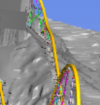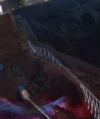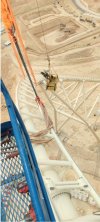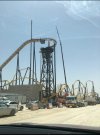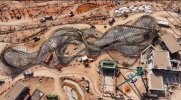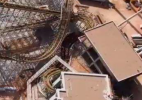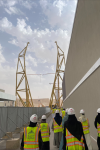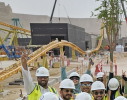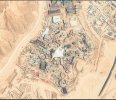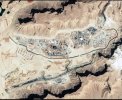You are using an out of date browser. It may not display this or other websites correctly.
You should upgrade or use an alternative browser.
You should upgrade or use an alternative browser.
Six Flags Qiddiya| Saudi Arabia | Theme Park
- Thread starter Matt N
- Start date
Crazycoaster
Giga Poster
Is it airtime, or is it just a change in gradient like Wicker Mans lift?
JuliOverbank
Roller Poster
That's what I call a "high-speed lift hill"!
TPoseOnTantrum
Giga Poster
IGwaziSolos
Roller Poster
I like to take that statement back, spitfire is perfect for the park, most of the people in Saudi haven't ridden a coaster before or at most 5 coasters that are near by, which is in the UAE ( this includes me i've only been to the parks in Dubai and this week i went to the parks in the Gold Coast, Australia )I feel like the most useless coaster in this park is spitfire, like what role does it serve
so most people would find falcon's flight and Iron Rattler too intimidating and a big step from Colossus so Spitfire is a great ride to fill that gap it's not a long ride and has one inversion and 240feet tall, so it's going to be most people's first ride that has an inversion and over 200 feet.
( i just realized that because yesterday i went to movie world, Gold Coast and when it was time to ride DC Rivals i was too intimidated and didn't ride it i'm planning to go back tomorrow and ride it)
Well next to Falcons flight it's going to look like a kiddy coasterWhen the 240ft coaster is considered the „step-up“ ride in a park
RollerCoastersFrolicking
Mega Poster
my brother in Christ is that a double zero-G roll I seeSource: themeparkxView attachment 31388
This was already mentioned in the Top Thrill 2 thread, but I think it bears repeating here.
One thing that really baffles me about Falcon's Flight is the level of technical risk involved. Risk, as we all know, is best defined as a sort of combination between the consequences of something going wrong, and the probability of something going wrong. In this respect, "something going wrong" is any given factor that can cause the ride to go out of the boundaries of safe operation, and trigger a shut-down of some duration. Those can range from e-stops that are quickly fixed so the ride goes back online in a few minutes, to the ride being shut down for years for extensive rebuilds.
Just consider how many things have to not go wrong for a coaster to operate properly. Every piece of track and every support need to be checked and okayed regularly. The trains need to have all their components in order. The launch systems, and their power supplies, need to function properly. Moving parts have to be oiled, firm parts have to be fastened, bolts must regularly be tightened, and every sensor and detector of the control system need to talk properly together. There are many failure points on even a simple coaster (as evident by the relatively frequent closure of any given attraction at any given park); likewise, big coasters have many failure points, and Falcon's Flight is ... well, it's completely befuddling why they ever chose to build it.
Just consider how much track needs to be regularly inspected here. How many connections must be looked over every now and then. The number of sensors, and all the wiring. Heck, just consider the distance between the station, the lift hill, and the LSM booster sections. Parts of this coaster are on opposite sides of the park. One control system needs to oversee all the relevant components together, and signals must flow correctly both ways all the time, across kilometers of cables. Even keeping the wiring in order must be one heck of a job. Then all the LSM fins, and the lift hill, and the brakes, and all the jazz that goes on in the station ... And not to mention, there's a tunnel. Granted, not a long or deep one, but tunnels are always a concern.
So that's the list of stuff that can go wrong, and even a relatively minor failure in one component can force the ride to shut down. And then we have to factor in the probabilities. That's where things go somewhat crazy.
Let's just start with the trains, heck, that's a long chapter in itself. With the speeds involved, and the length of track, imagine how much wear and tear the trains will have to endure for every single ride cycle. This coaster is 50% faster than Millennium Force and twice as long. And it's located in the middle of the Saudi desert, with all the sunshine and heat that implies during the daytime, and a relatively extreme temperature difference between day and night. The cyclical loads of thermal expansion alone must be quite spectacular, and it probably has some funny effects on the viscosity of lubricants too. Wind can probably also be a concern with such a tall coaster. The trains must also be configured to deal with both LSM propulsion and a lift hill, that's two sets of failure points there as well.
I mean, consider that big coasters often come with problems. Just recently, we've seen Lightning Rod be out for months at a time on several occasions because of its booster lift. Steel Curtain, a rather small and modest ride compared to this, went out for the foreseeable future due to technical problems. Do-Dodonpa was scrapped over them. Intimidator 305 had to be modified because of its forcefulness. Maverick famously lost its inline twist. Hagrid's Coaster had some of the worst reliability records ever seen in the industry. Falcon's Flight features most of the same challenges, but is vastly bigger.
In short, this coaster is tempting Murphy's Law on a level we've never seen before. Probably for very good reasons. Keeping this thing operational means that a lot of things has to not go wrong, continuously. The probability of any given component working correctly might be very high, but when operation is dependent on hundreds of components working together, the total probability of failure creeps inexorably upwards. In a chain of 250 components, each 99% reliable, your signal will only get through 8% of the time.
Of course, risk can be mitigated. There are many systems out there with vastly more complexity in vastly more challenging climates, and near-perfect uptime - oil refineries or large power plants come to mind. But those systems tend to be supervised around-the-clock by specialized engineering firms with shelves full of contingency plans, checklists longer than a Dickens novel, and maintained solely by people who spent years in college before they were even allowed to look at the system. That level of operational safety is only afforded due to the spectacular flow of money involved in the operation.
This, on the other hand, is an amusement park. Hardly the type of place that can afford to revise its FMECA every six months, or employ an army of specialist engineers for every subsystem. Guests don't leave that much money at the gate. I also don't think Intamin does its systems risk management at the scope or level of process engineering firms. Although I think there are other amusement attractions out there with a similar level of complexity (Hagrid's Motorbike Trademark Phrase and Rise of the Resistance spring to mind), the sheer level of forces, wear, and tear here are taking the cake to a whole new level. It's a forceful ride, outdoors in a harsh climate, spread across a very large site, by a company that doesn't quite have the best reliability record out there. And I really doubt they'll have Disney or Universal levels of money to spend on maintenance. Regardless of their aspirations, Qiddiya is not Orlando. They won't see millions of guests spending hundreds of dollars per day, at least not within any foreseeable future. Just look to the parks in Dubai, which is a bigger and vastly more visited city. I just can't see this park receiving the footfall required to afford the upkeep of such a monstrously complex coaster.
In other words, it would shock me if they could get this thing to operate reliably.
One thing that really baffles me about Falcon's Flight is the level of technical risk involved. Risk, as we all know, is best defined as a sort of combination between the consequences of something going wrong, and the probability of something going wrong. In this respect, "something going wrong" is any given factor that can cause the ride to go out of the boundaries of safe operation, and trigger a shut-down of some duration. Those can range from e-stops that are quickly fixed so the ride goes back online in a few minutes, to the ride being shut down for years for extensive rebuilds.
Just consider how many things have to not go wrong for a coaster to operate properly. Every piece of track and every support need to be checked and okayed regularly. The trains need to have all their components in order. The launch systems, and their power supplies, need to function properly. Moving parts have to be oiled, firm parts have to be fastened, bolts must regularly be tightened, and every sensor and detector of the control system need to talk properly together. There are many failure points on even a simple coaster (as evident by the relatively frequent closure of any given attraction at any given park); likewise, big coasters have many failure points, and Falcon's Flight is ... well, it's completely befuddling why they ever chose to build it.
Just consider how much track needs to be regularly inspected here. How many connections must be looked over every now and then. The number of sensors, and all the wiring. Heck, just consider the distance between the station, the lift hill, and the LSM booster sections. Parts of this coaster are on opposite sides of the park. One control system needs to oversee all the relevant components together, and signals must flow correctly both ways all the time, across kilometers of cables. Even keeping the wiring in order must be one heck of a job. Then all the LSM fins, and the lift hill, and the brakes, and all the jazz that goes on in the station ... And not to mention, there's a tunnel. Granted, not a long or deep one, but tunnels are always a concern.
So that's the list of stuff that can go wrong, and even a relatively minor failure in one component can force the ride to shut down. And then we have to factor in the probabilities. That's where things go somewhat crazy.
Let's just start with the trains, heck, that's a long chapter in itself. With the speeds involved, and the length of track, imagine how much wear and tear the trains will have to endure for every single ride cycle. This coaster is 50% faster than Millennium Force and twice as long. And it's located in the middle of the Saudi desert, with all the sunshine and heat that implies during the daytime, and a relatively extreme temperature difference between day and night. The cyclical loads of thermal expansion alone must be quite spectacular, and it probably has some funny effects on the viscosity of lubricants too. Wind can probably also be a concern with such a tall coaster. The trains must also be configured to deal with both LSM propulsion and a lift hill, that's two sets of failure points there as well.
I mean, consider that big coasters often come with problems. Just recently, we've seen Lightning Rod be out for months at a time on several occasions because of its booster lift. Steel Curtain, a rather small and modest ride compared to this, went out for the foreseeable future due to technical problems. Do-Dodonpa was scrapped over them. Intimidator 305 had to be modified because of its forcefulness. Maverick famously lost its inline twist. Hagrid's Coaster had some of the worst reliability records ever seen in the industry. Falcon's Flight features most of the same challenges, but is vastly bigger.
In short, this coaster is tempting Murphy's Law on a level we've never seen before. Probably for very good reasons. Keeping this thing operational means that a lot of things has to not go wrong, continuously. The probability of any given component working correctly might be very high, but when operation is dependent on hundreds of components working together, the total probability of failure creeps inexorably upwards. In a chain of 250 components, each 99% reliable, your signal will only get through 8% of the time.
Of course, risk can be mitigated. There are many systems out there with vastly more complexity in vastly more challenging climates, and near-perfect uptime - oil refineries or large power plants come to mind. But those systems tend to be supervised around-the-clock by specialized engineering firms with shelves full of contingency plans, checklists longer than a Dickens novel, and maintained solely by people who spent years in college before they were even allowed to look at the system. That level of operational safety is only afforded due to the spectacular flow of money involved in the operation.
This, on the other hand, is an amusement park. Hardly the type of place that can afford to revise its FMECA every six months, or employ an army of specialist engineers for every subsystem. Guests don't leave that much money at the gate. I also don't think Intamin does its systems risk management at the scope or level of process engineering firms. Although I think there are other amusement attractions out there with a similar level of complexity (Hagrid's Motorbike Trademark Phrase and Rise of the Resistance spring to mind), the sheer level of forces, wear, and tear here are taking the cake to a whole new level. It's a forceful ride, outdoors in a harsh climate, spread across a very large site, by a company that doesn't quite have the best reliability record out there. And I really doubt they'll have Disney or Universal levels of money to spend on maintenance. Regardless of their aspirations, Qiddiya is not Orlando. They won't see millions of guests spending hundreds of dollars per day, at least not within any foreseeable future. Just look to the parks in Dubai, which is a bigger and vastly more visited city. I just can't see this park receiving the footfall required to afford the upkeep of such a monstrously complex coaster.
In other words, it would shock me if they could get this thing to operate reliably.
With all this in mind - I don't think Six Flags Qiddiya will be reliant only Falcon's Flight alone to be successful (gratefully). The park, much like it's crown jewel, remains massive in scale, and will have a lot to offer beyond any one singular roller coaster. This at least will help having a wider portfolio of rides to soften any downtime blows, even moreso than we've seen with other Middle East parks like Motiongate or Ferrari World.This was already mentioned in the Top Thrill 2 thread, but I think it bears repeating here.
One thing that really baffles me about Falcon's Flight is the level of technical risk involved. Risk, as we all know, is best defined as a sort of combination between the consequences of something going wrong, and the probability of something going wrong. In this respect, "something going wrong" is any given factor that can cause the ride to go out of the boundaries of safe operation, and trigger a shut-down of some duration. Those can range from e-stops that are quickly fixed so the ride goes back online in a few minutes, to the ride being shut down for years for extensive rebuilds.
Just consider how many things have to not go wrong for a coaster to operate properly. Every piece of track and every support need to be checked and okayed regularly. The trains need to have all their components in order. The launch systems, and their power supplies, need to function properly. Moving parts have to be oiled, firm parts have to be fastened, bolts must regularly be tightened, and every sensor and detector of the control system need to talk properly together. There are many failure points on even a simple coaster (as evident by the relatively frequent closure of any given attraction at any given park); likewise, big coasters have many failure points, and Falcon's Flight is ... well, it's completely befuddling why they ever chose to build it.
Just consider how much track needs to be regularly inspected here. How many connections must be looked over every now and then. The number of sensors, and all the wiring. Heck, just consider the distance between the station, the lift hill, and the LSM booster sections. Parts of this coaster are on opposite sides of the park. One control system needs to oversee all the relevant components together, and signals must flow correctly both ways all the time, across kilometers of cables. Even keeping the wiring in order must be one heck of a job. Then all the LSM fins, and the lift hill, and the brakes, and all the jazz that goes on in the station ... And not to mention, there's a tunnel. Granted, not a long or deep one, but tunnels are always a concern.
So that's the list of stuff that can go wrong, and even a relatively minor failure in one component can force the ride to shut down. And then we have to factor in the probabilities. That's where things go somewhat crazy.
Let's just start with the trains, heck, that's a long chapter in itself. With the speeds involved, and the length of track, imagine how much wear and tear the trains will have to endure for every single ride cycle. This coaster is 50% faster than Millennium Force and twice as long. And it's located in the middle of the Saudi desert, with all the sunshine and heat that implies during the daytime, and a relatively extreme temperature difference between day and night. The cyclical loads of thermal expansion alone must be quite spectacular, and it probably has some funny effects on the viscosity of lubricants too. Wind can probably also be a concern with such a tall coaster. The trains must also be configured to deal with both LSM propulsion and a lift hill, that's two sets of failure points there as well.
I mean, consider that big coasters often come with problems. Just recently, we've seen Lightning Rod be out for months at a time on several occasions because of its booster lift. Steel Curtain, a rather small and modest ride compared to this, went out for the foreseeable future due to technical problems. Do-Dodonpa was scrapped over them. Intimidator 305 had to be modified because of its forcefulness. Maverick famously lost its inline twist. Hagrid's Coaster had some of the worst reliability records ever seen in the industry. Falcon's Flight features most of the same challenges, but is vastly bigger.
In short, this coaster is tempting Murphy's Law on a level we've never seen before. Probably for very good reasons. Keeping this thing operational means that a lot of things has to not go wrong, continuously. The probability of any given component working correctly might be very high, but when operation is dependent on hundreds of components working together, the total probability of failure creeps inexorably upwards. In a chain of 250 components, each 99% reliable, your signal will only get through 8% of the time.
Of course, risk can be mitigated. There are many systems out there with vastly more complexity in vastly more challenging climates, and near-perfect uptime - oil refineries or large power plants come to mind. But those systems tend to be supervised around-the-clock by specialized engineering firms with shelves full of contingency plans, checklists longer than a Dickens novel, and maintained solely by people who spent years in college before they were even allowed to look at the system. That level of operational safety is only afforded due to the spectacular flow of money involved in the operation.
This, on the other hand, is an amusement park. Hardly the type of place that can afford to revise its FMECA every six months, or employ an army of specialist engineers for every subsystem. Guests don't leave that much money at the gate. I also don't think Intamin does its systems risk management at the scope or level of process engineering firms. Although I think there are other amusement attractions out there with a similar level of complexity (Hagrid's Motorbike Trademark Phrase and Rise of the Resistance spring to mind), the sheer level of forces, wear, and tear here are taking the cake to a whole new level. It's a forceful ride, outdoors in a harsh climate, spread across a very large site, by a company that doesn't quite have the best reliability record out there. And I really doubt they'll have Disney or Universal levels of money to spend on maintenance. Regardless of their aspirations, Qiddiya is not Orlando. They won't see millions of guests spending hundreds of dollars per day, at least not within any foreseeable future. Just look to the parks in Dubai, which is a bigger and vastly more visited city. I just can't see this park receiving the footfall required to afford the upkeep of such a monstrously complex coaster.
In other words, it would shock me if they could get this thing to operate reliably.
The downtime and disappointing the guests is one thing, but the sheer effort required to keep Falcon's Flight operational will be a huge tax on the park in any case. It's a very maintenance-heavy coaster, requiring constant attention to all the things that can go wrong. Its upkeep will be very, very expensive even in the best-case scenario, and potentially much more so if things don't work out as planned. It's going to be a hog on the budget in any case.With all this in mind - I don't think Six Flags Qiddiya will be reliant only Falcon's Flight alone to be successful (gratefully). The park, much like it's crown jewel, remains massive in scale, and will have a lot to offer beyond any one singular roller coaster. This at least will help having a wider portfolio of rides to soften any downtime blows, even moreso than we've seen with other Middle East parks like Motiongate or Ferrari World.
With that in mind, I can't help but see a comparison to Lightwater Valley, of all places. They too built a ride that was a bit too big for the park, and the costs associated with its operation was probably a major contributor to the park's relatively modest investments even as the other parks in the UK sized up around the turn of the millennium. The Ultimate was a bigger bite than they could chew in the long run. Granted, though, they got 25 years or so out of The Ultimate, but when those 25 years were up and the coaster had to go, the park hadn't grown very much in the meantime.
The potential trouble for Six Flags Qiddiya is that they are committing to a lot of upkeep costs from the get go, in an area without much established tourism or local traditions for going to amusement parks. Even the other coasters they are building will require a hefty footfall for the investment and upkeep to break even, but Falcon's Flight adds another huge pile of risk on top of all that. The park really needs to be a massive success from, perhaps not day one, but certainly some of the first days, if they want to afford keeping their rides open. And that assumes they work perfectly. If not, well ... I think Falcon's Flight will be a very rare cred indeed.
Gazza
Giga Poster
Don't know how I missed this? Is this basically a Red Force / Stealth type thing, but with a reverse spike and inverted tophat?More on Spitfire. Inverted tophat supports are in, and check out that airtime hill during the swing launch!
View attachment 31535
View attachment 31536
Seems like an interesting choice in the lineup considering everything rise on offer.
Last edited:

